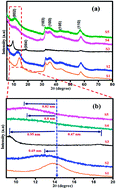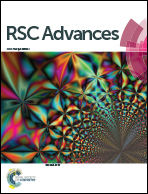Ultrathin layered MoS2 nanosheets with rich active sites for enhanced visible light photocatalytic activity†
Abstract
Edge-rich active sites of ultrathin layered molybdenum disulphide (MoS2) nanosheets were synthesized by a hydrothermal method. The effect of pH on the formation of MoS2 nanosheets and their photocatalytic response have been investigated. Structural and elemental analysis confirm the presence of S–Mo–S in the composition. Morphological analysis confirms the presence of ultrathin layered nanosheets with a sheet thickness of 10–28 nm at pH 1. The interplanar spacing of MoS2 layers is in good agreement with the X-ray diffraction and high-resolution transmission electron microscopy results. A comparative study of the photocatalytic performance for the degradation of methylene blue (MB) and rhodamine B (RhB) by ultrathin layered MoS2 under visible light irradiation was performed. The photocatalytic activity of the edge-rich ultrathin layered nanosheets showed a fast response time of 36 min with the degradation rate of 95.3% of MB and 41.1% of RhB. The photocatalytic degradation of MB was superior to that of RhB because of the excellent adsorption of MB than that of RhB. Photogenerated superoxide radicals were the key active species for the decomposition of organic compounds present in water, as evidenced by scavenger studies.



 Please wait while we load your content...
Please wait while we load your content...